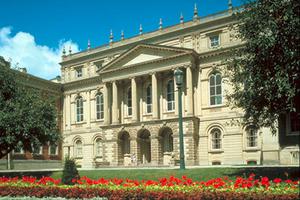Legal Education
Because all provinces but Québec inherited the English COMMON LAW, legal education in Canada - training for the practice of law - was in the beginning modelled on that in England. In England, however, the profession was and is divided into 2 mutually exclusive branches - BARRISTERS and SOLICITORS. Solicitors deal with clients, but if there is to be a trial in the High Court a barrister must be retained to act as counsel. Barristers, who have the exclusive right to represent a party at a trial or on appeal, are the "senior" branch of the profession, but until very recently the educational qualifications were very low. Although most barristers have a university degree (not necessarily in law), it is not obligatory, and students can still become barristers without having ever been in court. Solicitors, however, must be articled clerks to practising solicitors and must pass examinations. The basic period was recently changed from 5 years to 4, which can be reduced to as little as 2 if the candidate passes certain qualifying examinations and has a university degree.
In Canada (except Québec) the division of the profession into 2 mutually exclusive branches has not occurred; today a legal practitioner in the common law provinces is invariably both a solicitor and a barrister, though in practice many act in the capacity of one or the other.
Before the establishment of the modern law school, the typical provincial Act governing the legal profession provided that applicants had to spend 5 years under articles and to write periodic examinations, though if they held a university degree the period was reduced to 3 years. When modern law schools were established, the articling period was usually reduced to one year after graduation. In Ontario and Manitoba it was once possible to combine part-time law school with part-time articles, but now these provinces have the same system as the others.
In Canada, as in the US, and unlike England, students do not come directly from high school to law school. The usual minimum is 2 years of university education and most successful applicants have a degree.
Law Schools
The story of the common-law schools can be divided into 2 periods - from the founding of the Dalhousie Law School in 1883 to 1945, and from 1945 to the present. Dalhousie established a full-time 3-year course soon after the school was founded. It had always had links to Harvard Law School and at the end of WWI its curriculum resembled that of Harvard. Following the recommendations of the CANADIAN BAR ASSOCIATION in 1920, this curriculum was widely accepted by other common-law schools.
In Ontario the Law Society created its own law school, OSGOODE HALL, in 1862, though it closed and reopened twice before being put on a permanent foundation in 1889. Later the universities of New Brunswick, Manitoba, Saskatchewan, Alberta and BC established law schools.
Shortly after WWII the Law Society made Osgoode a full-time school. The University of Toronto had long given a degree in law. In 1949 the faculty was reorganized under Dean C.A. Wright and Bora LASKIN so as to make the LLB a professional course that would lead to admission to the bar. However, the Law Society did not give complete recognition to other schools in Ontario until 1957. In 1968 the society gave up its school and Osgoode Hall became a part of York U. By that time there were 6 faculties in Ontario - at the universities of Ottawa, Toronto, Western Ontario, Windsor, Queen's and York - and in other provinces law schools were also established at the universities of Victoria, Calgary and Moncton (where instruction is in French), and a common-law course was begun at McGill. By 1987 the number of full-time teachers had risen from about 20 to about 450 and student enrolment is now in the thousands. Most law schools impose a quota on admissions. One notable postwar trend has been the marked increase in women students and in women law teachers.
Curriculum
The standard curriculum of 1920 remained virtually unchanged until 1945. In 1957 the Law Society of Upper Canada prescribed the courses it would require of "approved" schools, making amendments in 1969. As all the common-law schools are approved, it is clear that the Ontario prescription has influenced the curriculum in all common-law schools. There are 25 subject areas, with 6 compulsory "core subjects." The object is to provide a general education that permits a degree of specialization. In some law schools there is special emphasis on specific topics; eg, taxation or oil and gas law.
The teaching method in common-law schools was originally based on the "case method" created in the 1870s by Dean Langdell at Harvard Law School, who believed that law was a science composed of principles that could be learned from reading decisions of appellate courts. Formal lectures were replaced by discussions in class of assigned cases and by questioning of the Socratic type. By the 1920s, all common-law schools in Canada employed one or other variation of the case method.
Since WWII, the use of the case method, at least after the first year of law school, has been criticized on the grounds that it is unproductive and gives a misleading view of law in action. Legislation tends to be ignored in the reading of cases, although its pre-eminent place is now being recognized. There has been emphasis as well on problem solving and legal writing, and on public law as compared to private. Since patriation or the Canadian Constitution in 1982, increasing attention is being paid to burgeoning cases interpreting the Charter of Rights and Freedoms. Courses in criminal law and evidence, ADMINISTRATIVE LAW and CONSTITUTIONAL LAW, have all been significantly affected, and altered, to allow for consideration of the leading Charter cases. Another trend is the linking of law with other disciplines (eg, economics, history, psychology and sociology); and to answer the criticism that law school study ignores pressing social needs, there are courses in poverty law, WOMEN AND THE LAW, and CIVIL LIBERTIES. There has been an effort to strengthen courses on legal theory, the philosophy of law and sociology of law, usually under the rubric of JURISPRUDENCE. Two powerful perspectives on traditional legal theory, feminism and critical legal studies, have emerged in the last few years and have invigorated debates in the law schools. Efforts have been made as well to teach ethics and professional responsibility.
Clinical Training
The development of these new subjects is not always strong and has to face competition with other subjects. As a result of criticism that law schools fail to teach skills necessary in legal practice - drafting documents, writing opinions, preparing for trial and cross-examination, interviewing and negotiating - there has been increasing emphasis on clinical training. Many law schools are introducing courses which will expose students to alternative methods of resolving disputes, such as mediation and arbitration. This trend reflects the increasing resort to A.D.R. in practice. Considerable effort has been made to meet this demand, usually with the help of practitioners and judges. Like every innovation, however, its place in the law school has been debated.
The production of legal journals has conspicuously increased. These journals usefully provide scholarly articles and a forum for criticism and for proposals for reform. Computers have become indispensable to the modern lawyer and many schools have introduced computer labs for student use and are training students in computer research skills. Some courses are now offered on the Internet and it will not be long until electronic libraries of legal information become vital resources for the study and practice of law.
The 1983 report of the Arthurs Committee on Legal Education, Law and Learning states that law schools are "eclectic" and still overemphasize training for the professional rather than the academic. The report advocates research at a high level to help the development of a "scholarly" discipline that will not be shunted aside from professional training. The report specifically recommends an expansion and intensification of graduate study (a number of schools give a master's degree and a few offer a doctorate) with a view to the education of future law teachers and researchers, and recommends that these programs should concentrate on those subjects in which the school is strong. Support for graduate research is hampered, however, by the shortage of funds for scholarships.
Articling
The advent of the law school did not mean an end to the system of articles. The purpose of articling is to provide "practical" training; ie, an introduction to practice which the law school has not provided. The success of articles depends on the "principal" and the student. The principal is under a duty to see that the student receives instruction in the basics of practice, but there is little or no supervision to this end. For many years after WWII, the business expansion created a demand for students and good articles were comparatively easy to obtain. In recent years, the number of graduates has been more than the market can easily absorb and the adequacy of the articling system has come into question. To supplement articles, most law societies have established a Bar Admission Course. The most notable is that of Ontario, begun in 1957. When students have finished the year of articles, they are required to attend a 6-month course in matters such as rules of procedure, forming companies, handling estates, and real-estate transactions. This course is described in a handbook published by the Law Society of Upper Canada. The other provinces, except for PEI, have each provided in legislation for a bar admission course. However, these courses are less ambitious than Ontario's and vary a great deal. Some are given throughout the period of articles while others are offered near the end of the articling period, the length of the course varying from one week to 6.
In the mid-1980s BC replaced its Bar Admission Program by a Professional Legal Training Course. It is 10 weeks in length and offered 3 times a year to articling students. They take part in true-to-life transactions likely to be encountered in practice and receive training in the major skills. This scheme shows promise of being an improvement on the typical bar admission course and other provinces are examining it.
In the US, the requirement of articles is virtually nonexistent. In theory, admission to practice is a matter for the state supreme court. The court in fact delegates its function to bar examiners who set comprehensive exams for those seeking to practise, and who conduct character checks. Another difference between the 2 countries is that the American Bar Association publishes a list of approved law schools, though some unapproved schools still exist; the Canadian Bar Association has no such role and there is no category of unauthorized law schools. Finally, the Canadian type of provincial law society, with statutory control over admission and discipline, is quite different from the type of law society in the US.
Continuing Legal Education
Once an individual has been admitted to practice, it is important to keep up to date. Legal journals and special lectures and meetings of bar associations are helpful but provide uneven coverage and do not always reach those most in need. In recent years there has been a call for a greater and more systematic program of continuing legal education. In 1978 the Federation of Law Societies of Canada held a Conference on Quality of Legal Services and in 1980 held a workshop on the same subject. It concluded that continuing legal education should be fostered but it was not prepared to recommend mandatory continuing legal education. Organized efforts at programs of continuing legal education are in fact increasing in most provinces.
The legal profession (outside Québec) has never recognized specialties, as does the medical profession, though in some provinces practitioners may now announce a preferred area of practice. The significant fact is that the "practice of law" is not homogenous, and the variations go far beyond the differences between barrister and solicitor. In addition, lawyers work not only in private practice but also in government and business.
In Québec the legal profession is divided. Advocates form the Barreau du Québec while notaries, governed by their own statute, are somewhat like solicitors. An individual cannot belong to both branches. The course leading to a degree in law in Québec takes 3 years, and the prelegal requirement is a diploma equivalent to an arts degree. If law students wish to become notaries, they must declare so by December 1 of their third year. Up to that point, the courses are the same for both branches, with emphasis on the CIVIL CODE, which comprises the basic statement of legal relations as between private citizens - contracts, property, inheritance, etc. In many other ways the Québec schools have gone through the same experiences and problems as the common-law schools. The first faculty of law in Canada was established in 1853 at McGill, which now gives a common law as well as a civil law degree (as does U of O). Laval's law faculty was founded in 1854 and that of U de M is over 100 years old. Other law schools exist at Sherbrooke and the Université de Québec at Montréal.
Practical training occurs after graduation. For advocates there is an 8-month formation professionelle (similar to a bar admission course), followed by a stagiaire (now similar to BC's new program in skills training) of 6 months, and finally a bar examination. Graduates who wish to be notaries must attend an additional year in notarial practice at a civil law school; finally, they take a notarial examination.

 Share on Facebook
Share on Facebook Share on X
Share on X Share by Email
Share by Email Share on Google Classroom
Share on Google Classroom




